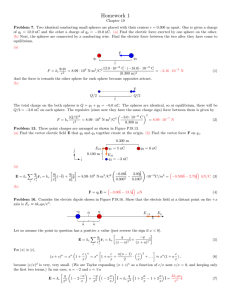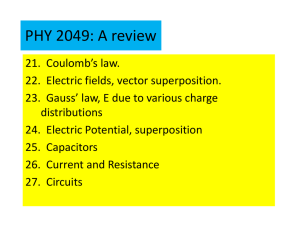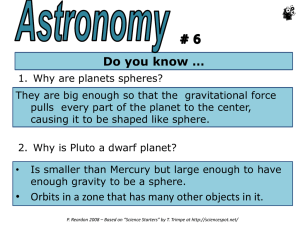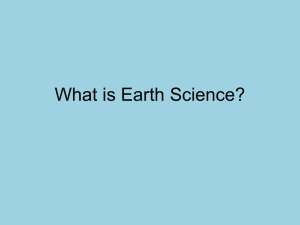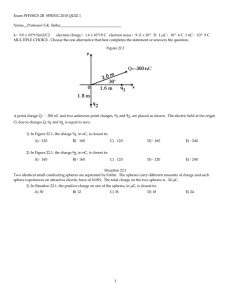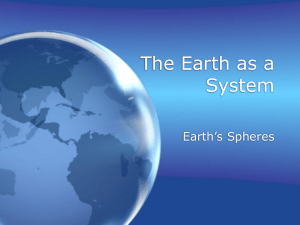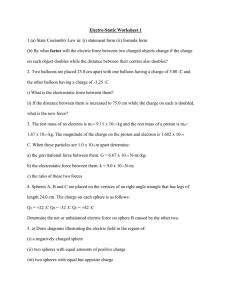Two conducting spheres in a parallel electric field
advertisement
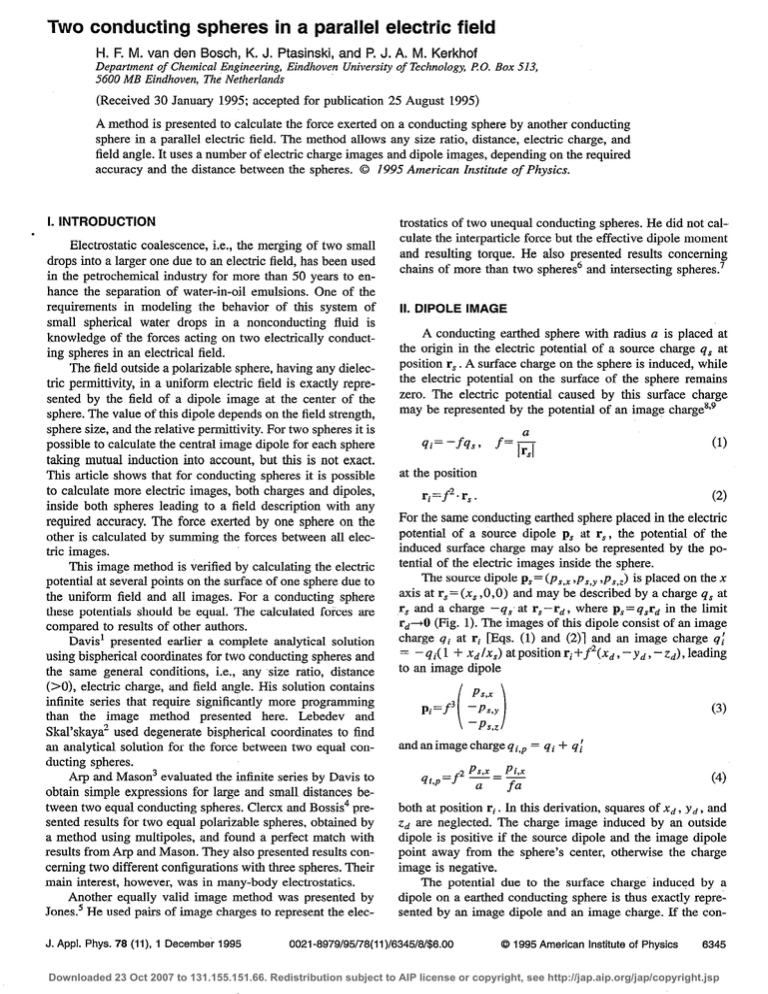
Two conducting spheres in a parallel electric field H. F. M. van den Bosch, K. J. Ptasinski, and P. J. A. M. Kerkhof Department of Chemical Engineering, Eindhoven University of Technology, P.0. Box 513, 5600 MB Eindhoven, The Netherlands (Received 30 January 1995; accepted for publication 25 August 1995) A method is presented to calculate the force exerted on a conducting sphere by another conducting sphere in a parallel electric field. The method allows any size ratio, distance, electric charge, and field angle. It uses a number of electric charge images and dipole images, depending on the required accuracy and the distance between the spheres. 0 1995 American Institute of Physics. . 1. INTRODUCTION Electrostatic coalescence, i.e., the merging of two small drops into a larger one due to an electric field, has been used in the petrochemical industry for more than 50 years to enhance the separation of water-in-oil emulsions. One of the requirements in modeling the behavior of this system of small spherical water drops in a nonconducting fluid is knowledge of the forces acting on two electrically conducting spheres in an electrical field. The field outside a polarizable sphere, having any dielectric permittivity, in a uniform electric field is exactly represented by the field of a dipole image at the center of the sphere. The value of this dipole depends on the field strength, sphere size, and the relative permittivity. For two spheres it is possible to calculate the central image dipole for each sphere taking mutual induction into account, but this is not exact. This article shows that for conducting spheres it is possible to calculate more electric images, both charges and dipoles, inside both spheres leading to a field description with any required accuracy. The force exerted by one sphere on the other is calculated by summing the forces between all electric images. This image method is verified by calculating the electric potential at several points on the surface of one sphere due to the uniform field and all images. For a conducting sphere these potentials should be equal. The calculated forces are compared to results of other authors. Davis’ presented earlier a complete analytical solution using bispherical coordinates for two conducting spheres and the same general conditions, i.e., any size ratio, distance (>O), electric charge, and field angle. His solution contains infinite series that require significantly more programming than the image method presented here. Lebedev and Skal’skaya’ used degenerate bispherical coordinates to find an analytical solution for the force between two equal conducting spheres. Arp and Mason3 evaluated the infinite series by Davis to obtain simple expressions for large and small distances between two equal conducting spheres. Clercx and Bossis presented results for two equal polarizable spheres, obtained by a method using multipoles, and found a perfect match with results from Arp and Mason. They also presented results concerning two different configurations with three spheres. Their main interest, however, was in many-body electrostatics. Another equally valid image method was presented by Jones.’ He used pairs of image charges to represent the elecJ. Appt. Phys. 78 (II), 1 December 1995 trostatics of two unequal conducting spheres. He did not calculate the interparticle force but the effective dipole moment and resulting torque. He also presented results concerning chains of more than two sphere8 and intersecting spheres.7 II. DIPOLE IMAGE A conducting earthed sphere with radius a is placed at the origin in the electric potential of a source charge qs at position r, . A surface charge on the sphere is induced, while the electric potential on the surface of the sphere remains zero. The electric potential caused by this surface charge may be represented by the potential of an image charge8*9 qi=-fqsrfzalrsl at the position JTi’f2’r*. (2) For the same conducting earthed sphere placed in the electric potential of a source dipole ps at r,, the potential of the induced surface charge may also be represented by the potential of the electric images inside the sphere. The source dipole ps= (p,,, ,P#,~,p,,,) is placed on the x axis at r, = (x, ,O,O) and may be described by a charge qs at r, and a charge -qsm at I’,-rd , where ps= q,rd in the limit r,+O (Fig. 1). The images of this dipole consist of an image charge qi at ri [Eqs. (1) and (2)] and an image charge q! = - qi( 1 + xd lx,) at position ri + f 2(xd, - yd , - zd), leading to an image dipole pi=f3 PS,X -PS,y ( -P&Z. i (31 and an image charge qi,p = qi + 41 q, =f2 1.P PSJ =PiJ a fa both at position ri . In this derivation, squares of xd, yd , and zd are neglected. The charge image induced by an outside dipole is positive if the source dipole and the image dipole point away from the sphere’s center, otherwise the charge image is negative. The potential due to the surface charge induced by a dipole on a earthed conducting sphere is thus exactly represented by an image dipole and an image charge. If the con- 0021-8979/95/78(11)/6345/8/$6.00 Q 1995 American Institute of Physics 6345 Downloaded 23 Oct 2007 to 131.155.151.66. Redistribution subject to AIP license or copyright, see http://jap.aip.org/jap/copyright.jsp respectively. The held may be decomposed into a component parallel and a component perpendicular to the distance vector d(d=r,-rd given by Eoll=~E&os 4and EaL=jEojsin 8, where 6 is the angle between the field direction and the distance vector. Two unit vectors e, and e., are defined to give Eo=Eorl-ell+E,,.e, . The first-order dipole images pA,t and pn,t at the centers of the spheres have components parallel and normal to the distance vector d given bygT9 FIG. 1. Relative positions for a pair of source charges and their induced images. ducting sphere is isolated, the total charge on the sphere remains unchanged, and any induced charge is compensated for by an extra opposite image charge located at the center of the sphere. Ill. TWO SPHERES Consider two spheres A and B with radii UA and an placed at r, and r, in a parallel electric field Es with arbitrary orientation (Fig. 2). The dielectric permittivities of the continuous phase and the particles are given by E and eP, ~A,111=4~E~a~EOII~ ~A,ll=4~~~a~EO~~ (5) PB,u=4+&o,, PB,11=4rr&3EOl, (6) 9 where /3= ( cp - E)/( ep + 2 E) . For large distances between the spheres these first-order dipoles give a good approximation for the electrostatics. A better approximation, that takes mutual induction into account, is treated in Sec. IV. The remainder of the article describes an “exact” method, using multiple image positions, that is valid only for conducting spheres (/?= 1). Two extra conditions must be imposed upon the system. Two possible ways for choosing these conditions are discussed in this article: (1) The potentials VA and V, of both spheres are separately fixed. With VA=VB=O, this case is equal to the “grounded” sphere constraint of Ref. 6. (2) .For isolated spheres, the charges qA and qn may be separately fixed to any value. With qA=qn=O, this case is equal to the “isolated” sphere constraint of Ref. 6. Another realizable set of conditions, not discussed in this article, is a fixed total charge and a fixed potential difference. This case was treated by Jones5 for two conducting unequal touching spheres with yA+qn=o and VA-VB=O. Other physically motivated sets of conditions may be envisioned. In case (1) (imposed potentials), the first-order charge images induced by those potentials and the external applied field are given by q&l=4re(vAt EC-rA)aA, (7) 63) 4B,1=4~TTE(VB+E”.rB)aB, where VA and V, are the imposed potentials relative to the potential at r=O. In case (2) (isolated spheres), the first-order charges are not defined. IV. ONE IMAGE POSITION FlG. 2. Dipole images inside two diierent spheres induced by an external the distance is electric field. The radii are rzA and nB=0.7a,, h=d-aA-aB~O.OO1u~ and the field makes an angle 6=m’3 with the dravin axis. A close-up shows the deviating Nth dipole and the mutual . . . mverslon pomt xA,-. 6346 J. Appl.’ Phys., Vol. 78, No. 11, 1 December 1995 .~The central images in both spheres may be. calculated taking mutual induction into account. This gives at moderate distances a better approximation then the first-order dipoles. The dipoles pA and pa are partly induced by the external field, leading to the first-order dipoles PA.1 and pn,t [&IS. (5) and (6)], and partly by the dipole image in the other sphere. The components parallel and normal to the distance vector are again considered separately. In case 1 [imposed potentials (p= l)] the dipoles are given by PAII=PA,HI+fbBIb PAI=PA,II-fbBd.3 ~Bll=PB,III+f3~Allr PBI-=PB;II -f&U c-4 7 (10) van den Bosch, Ptasinski, and Kerkhof Downloaded 23 Oct 2007 to 131.155.151.66. Redistribution subject to AIP license or copyright, see http://jap.aip.org/jap/copyright.jsp * ’ where fA=aAld and f n =aBld with d =ldl. As will frequently occur in the rest of this article, the solutions of these pairs of equations are found by substitution and are not presented. Similarly, the charge images are partly induced by both imposed voltage and field, leading to the first-order charges qA,l ami QB.1 @Is. (7) and @>I, and partly by the charge and dipole image in the other sphere All factors fA,k and fB,k are positive, and for equal spheres .fA,& = fB,k. For large values of k the positions of the images are very close to one another. The limit for the image positions is given by the mutual image positions found by rewriting Eqs. (15) and (16) as a; X&m=----, (17) -VB,m fA -jj-PBlb YA=(aA,l-fAqB+ 2 (11) XB,m =d- .fB -fBqA- C?B=qB,I (12) 2 PAlI. A positive parallel dipole image in sphere B points away from sphere A and induces a positive charge in sphere A. A positive parallel dipole image in sphere A points toward sphere B and induces a negative charge in sphere B. Case 2 (isolated spheres), with given charges qA and qn , is treated for any value of p. The parallel dipole image p Al,is induced by three field contributions 2PBll PAII 4m$a, 3 =Eo,,+ &&jT- qB hcd”’ The corresponding relations for &I1 and the normal components lead for both directions again to two equations with two unknowns. For neutral spheres these equations lead to the following dipole images: 1 -Pfil 1 +w.f; PAlI= PA.111~. hU==1-p2f3& PA,11 9 (13) 1 -/vi- 1 +Wfi PBll=1-4P~f3&PB,III~ &. &m These mutual image positions correspond to the two centers (,x=-~,+a) of the bispherical coordinate system used by Davis.’ To obtain a distance independent accuracy for all distances the value N for the last image included in the calculation is determined by its smallest value for which XA,m - XA,N< [, (19) X&m - .~/,,m where 5 may be set to any value &l. To obtain a distance independent accuracy for .$< lob3 and h > lo-” the denominator in Eq. (19) may be replaced with the smallest sphere radius aa . Other criteria for determining N are also possible. Vi. IMAGE DIPOLES The values of recurrent relations first-order dipoles (3), (15), and (16) the dipole images may be calculated with for both cases mentioned in Sec. III. The are given by Eqs. (5) and (6). Using Eqs. the higher-order dipoles k> 1 are given by PA.kII=f&B,k- III 7 PA,kl= ~B,kll=.d,kPA,k- 1111 PB,kl PBI=1-P2f3&PB,ll* (14) where f,q=aA/d and fB=a,/d. The parallel dipole COlIlpOnents are enlarged by the mutual induction, while the normal components are diminished. For very large distances the dipoles are equal to the first-order dipoles. For charged spheres, the parallel components also depend on both charges. -f&&Lk- Il. 7 (201 = -.f;,kPA,k- II * (21) The last dipoles PA,N and PB,N may be defined to contain all dipoles for kLN. This is achieved by assuming that the last dipole in one sphere is the image of the last two dipoles in the other sphere PA.NI,‘~~,N(PB,N-III~PB,NII)~ PA,NI= -f~,N(PB,N-II+PB,NI), Gw PB,NlI=f;,N(PA,N-lII+PA,NII), V. MULTIPLE IMAGE POSITIONS PB,NI = -~~,N(PA,N-II+PA,NI). For conducting spheres (p=l) more images at different positions may be used to represent the electrostatics, leading to any required accuracy. The x axis is taken through the centers of the spheres so rA=O and r,=(d,O,O) with d>O. All images are located inside the two spheres on the line connecting their centers, i.e., on the x axis (Fig. 2). The positions of the first images are given by: .vA.r=O and xB,*=d. The positions of all other images k>l are given by xA,k=fA,kaAr XB,k=d-fB,kai, The induced charge images are located at the same positions as the dipole images. Their values depend on the imposed potentials or, on the given total charges of the spheres. The multiple images case of imposed potentials for both spheres is treated in Sec. VII,. the case of given total charges is treated in Sec. VIII. VIL’IMPOSED ELECTRIC POTENTIALS For two spheres kept at potentials VA and VB the image charges can be calculated with recurrent relations. The firstorder charge images are given in Eqs. (7) and (8). All images in one sphere are electric sources for higher-order images in the other sphere. fA.k=$? fB,k=d-~~k-l. J. Appt. Phys., Vol. 78, No. 11, 1 December (2% 1995 van den Bosch, Ptasinski, and Kerkhof 6347 Downloaded 23 Oct 2007 to 131.155.151.66. Redistribution subject to AIP license or copyright, see http://jap.aip.org/jap/copyright.jsp N N d,l=qA-k2 4 -6 - -2 log(h) -% -1 I I 0 1 2 (2% q&k. The different sets of the aligned components of the image dipoles and image charges located at the positions given in Sec. V are represented as vectors PA = [pAIl, ,. ..,pA,&J, [qA,1v...JlA,NI~dQB. PB 3Qi = [d,, ~...4&,,NlrQf(~~A= The normal components of the image dipoles have no effect on the image charges. The contributions to the image charges inside one sphere induced by image charges in the other sphere are simply added as follows -2 logm-Va) ‘d3.1 =qB-k,2 z t&k? 3 (30) FIG. 3. Number of images N [5=le-3, Eq. (19)] used to calculate the potentials for the situation given in Fig. 2 with E= 1 V/a, and both spheres kept at potential V=O as function of the distance h=d-a,-a,, , and also the reached accuracy expressed in the remaining potential differences between the points b and, respectively, a, c, and d (see Fig. 2). QB=Q&+FB*QA, where QA and Qn are unknown. An image charge qn,k at. Xn,k in sphere B induces an image charge - fA,k+ IqB,k at xA,+i and an opposite image charge at the center xA,t of sphere A. Matrix FA is thus given by fA,2 For an imposed potential on both spheres the charge images are given by Eqs. (1) and (4), which leads to the following recurrent relations: -fs-fA.kqB,k-l. PB,kN qB,k= - fB,kaB 0 (24) PA.NII - fA,N-I fA,N fA,N f 0 0 0 -fA,3 . 0 0 0 0 * -f A,N- I 0 . 0 0 10 . fB NaB fB,N(qA,N+ qA,N- 1). The accuracy of the method can be found by calculating the electric potential for different points on the surface of a sphere (see Sec. IX, Fig. 3). For an isolated sphere, every induced charge image is compensated for by an extra opposite charge image at the center of the sphere. Every higher-order correction modifies the central. charge images and by that also all lower-order charge images are modified. It is possible to modify all charge images using recurrent relations. A more direct approach, leading to a faster algorithm, is described in this section. Considering only the charges induced by the image dipoles [Eq. (4)] leads for k&2 to PA kll fA,kaA’ -PB,kll &k= fB,kaB 08) . The central image charges are then given by 6346 J. App!. Phys., Vol. 78, No. 11, 1 December 1995 0 -f&N 0 -fA,N] (32) where the last two image charges in sphere B contribute in the same way to the last image charge in sphere A. Matrix FB iS Shih t0 FA with f n,k instead Of fA,k . Substituting l%$ (31) in Eq. (30) gives ’ (33) with I the identity matrix: Ijr= Sjj. The matrix I-FA-FB and the right-hand side of this equation are known. The charge (LUvector QA is solved by Crout’s algorithm decomposition) for general matrix inversion. For the symmetric case, i.e., an=aA, qn=-qA, PB=PA,Qk= -Qk, Qn=-QA,arldFn=FA,OlllyOnematrix equation is left, leading to U+FA).QA=QA- VIII. ISOLATED SPHERES qkkr---- , (I-FA.FB).QA=Qa+FA.Q;, fA,N(qB,N+qB,N-11, PB,NII qB,N= . 0 -fB,kqA,k-1. The last charge image in a sphere is again the image of the last two images in the other sphere and is found by solving the following two equations: qA.N- fANaA fA,3 -j-A,2 F,= qA,k- (31) (34) For the inversion of the matrix Eq. (34) a much faster algorithm, allowing much more images, is made to find QA. For an equal number of images the result is not as accurate as Crout’s algorithm because no pivoting is used. The accuracy can again be found by calculating the electric potential for different points on the surface of a sphere (see Sec. IX and Fig. 4). IX. POTENTIALS The method presented in this article is verified by calculating the potentials on several points on the surface of the spheres. All points on a conducting sphere should have the same potential. The sum of the potentials by the applied field and all calculated images for both spheres is given by van den Bosch, Ptasinski, and Kerkhof Downloaded 23 Oct 2007 to 131.155.151.66. Redistribution subject to AIP license or copyright, see http://jap.aip.org/jap/copyright.jsp a, c, and d (Fig. 2) according to Eq. (3.5). The number of images N is determined by Eq. 19 for t= 1 e -3. Both Figs. 3 and 4 show that for a stepwise increase of N the remaining potential differences decrease stepwise, i.e., including an extra image makes the calculation more accurate. The accuracy is limited by the maximum number of images and the precision of the variable types used. For the results shown the maximum value for N was set at 80, causing an increase of the remaining potential differences at the smallest distance. For two isolated spheres it follows from Fig. 4 that the potential difference between both spheres (V, - V,) hardly changes for small values of h. For decreasing distance h the electric field between two isolated spheres, given by (V, - V,)lh, may reach any value.3 Since any isolating material will only allow a certain field, electric breakdown will decrease the field between the spheres. The electric forces in the high field area may also cause mechanical deformations, i.e., the spherical shape that is required for this calculation method is then distorted. bN-0 FIG. 4. As Fig. 3, but for two isolated neutral spheres. V(r)=-E-r+ - X. SPHERE-SPHERE (35) For the case of two equal earthed spheres (VA=VB=Oj and two isolated neutral spheres, respectively, Figs. 3 and 4 show the potential differences between point b and the points PA,iliqB,j-qA,ipB,jll_ 4 FORCE The total force exerted on sphere B consists of a force due to the external field and a force due to the surface charge on sphere A, i.e., the mutual force. Using known force relations8’9 between charges and dipoles, this mutual force is found by a double summation. The motivation for the three separate rows is given below: 6 PA,illPB,jll 4 dij + 3 PA,ilPB,jl~ (36) dti qA,iPB,jl -PA,iLqB,j -3 +3 PA,illPB,fl~+PA,ilPB,jll d; where did = - xA,i . The force Fn,,t is opposite to the force exerted on sphere A by sphere B, i.e., FA,mut=-Fa,mut, so the total force exerted on each sphere is given by xB,j FA=~AEo-FB,~M~ (37) q&o (38) FB = B + FB,IIIW - For two isolated neutral spheres (qA=qn=Oj both the parallel image dipoles and image charges are proportional to E,,,, while the normal image dipoles are proportional to E,. The total field thus consists of a contribution due to E,,, and a contribution due to I&. The total force, that is equal to the mutual force, consists correspondingly of three contributions. The first row of Eq. (36) is proportional to E&, the second row to E& , and the third row to 2EollEoL. Divided by these field products and by 4reai, the three rows of Eq. (36) correspond-to the force functions F,, F,, and F,, respectively, as defined by Davis.’ These functions only depend on the relative geometry of the problem, i.e., J. Appl. Phys., Vol. 78, No. 11, 1 December 1995 as/a, and h/a,. Dividing the three rows of Eq. (36) by the corresponding expressions for the first-order dipoles only, i.e., -6P,,,uP,,,,,d-4, 3PA,uPB,ud-4, and 3(PA,,l~B,,, +pA,IgB,lll)d-4 leads to three positive dimensionless forces fll? fl 1 and fr , respectively, all approaching one for large distances, as used by Klingenberg” and Clercx and Bossis. Once these three-dimensionless forces are known, as function of size ratio and distance, the total force acting on sphere B is directly given by Fn= - 12rr&~a~a~d-4[(2 eelI.-fr f,,. cos’ a--fL sin” 4) sin 24-e,]. (39) Our results for these dimensionless forces for two equal conducting spheres (aA= an=a) correspond exactly to the values tabulated for h/a 32X 10m4 by Clercx and Bossis and by Arp and Mason3 (expressed as F, , F,, and F8). For smaller values ~of h/a our results approach the analytical expressions valid for hla -+ 1, derived by Arp and Mason3 from van den Bosch, Ptasinski, and Kerkhof 6349 Downloaded 23 Oct 2007 to 131.155.151.66. Redistribution subject to AIP license or copyright, see http://jap.aip.org/jap/copyright.jsp 3 la,) -a- -3 -2 -1 losCh$d 1 2 3 4 ” Gg(aA/8& FIG. 5. The dimensionless force f.,, as function of size ratio l~aA/ua~103 and relative distance 10-44zlaa404. the infinite series by Davis.’ This was verified for hlaa3X 10m7 using the faster inversion algorithm for Eq. (34) and 8000 image positions. Figures 5, 6, and 7 show the dimensionless forces f .,,, and fr as function of size ratio aA/an>l and relative f d&u-ice h/a,. At the elevated flat region of the surface plot for f .,, at larger size ratios, only the polarization of the small sphere is affected by mutual induction leading to f,,.=3[log(f,,.)= t/2]. The relatively steep region at a slightly smaller distance corresponds with the strong distance dependence of the central image charge in the large sphere at that distance. For two charged isolated spheres, the total field is a superposition of four independent contributions due to E,,,, E,, qA, and qB , leading to ten different field products contributing to the force Fn . Davis’ defined ten corresponding force functions depending only on sphere ratio and distance to give the total force. To determine these ten force functions with the method presented here requires calculation of three pairs of charge vectors QA and Qa induced separately by EoII, qA, and qs , respectively. The normal field component Eel does not induce any charges. For two earthed spheres with rAllrn , the induced charges are proportional to the parallel field component, and a similar approach as for isolated neutral spheres is possible, i.e., there are only two independent field contributions proportional to EOII and Eo,. FIG. 7. Dimensionless force fr(aAlaa , h/a,) Xl. CONTACTING (see Fig. 5). EARTHED SPHERES Two equal earthed contacting spheres (aA=aa=a, h=O, lead to the following simple set of images for sphere B: VA=VB=Oj Xk=-, a k Pill Pill qk=zr Pkll=F, PkJ. =‘$ (-l)k-‘v (40) where pl=47reEoa3. The positions are now given relative to the contact point. For sphere A the positions and charges have opposite signs while the dipoles are the same. This leads to the same equations for the net charge q = 4mxEolla2f(2) on sphere B and the effective dipole moments pII= 16PeEo,,a3[(3) and pI=6mEo,a3~(3) of both spheres, as presented earlier by Jones,’ where the following relations for Riemann’s zeta function l(s) are used s(sj=k~l $, 2 yik-* k=l =(1-2L-“)&s). The images also give the correct potential at the contact point V-O. The field near the contact point of the two earthed spheres may be expected to be very low. In a small area proportional to N-’ around the contact point, however, the images lead to a parallel field up to El,. = EoII-2NEoll, where N is the number of included images. This error may be corrected as follows. For two touching spheres Eq. (19) cannot be satisfied. Instead of the last images defined according to Sec. VI, the images k>N positioned from x=-aI(N+l) to x=al(N + 1) are replaced with a continuous line charge q ’= p 1,,la2, a continuous line dipole p ’=p ,,,xla’ from x =0 to x,= al(N+ l/2), and opposite line images from x = -X, to x=d. These line images lead to the following contribution to the parallel field between the spheres at a distance Sfrom the axiS -%I x(x2ElimAN> 4 = s I o (xz+ 2 82) 6;2)5/2 dx (41) -4 -3 -2 -1 1ozwL 1 2 FIG. 6. Dimensionless force fi(un/aa 6350 3 4 ” log(a,/aJ Near the contact point the sum of the inducing field EoII and the field of both the point and line images leads correctly to , hlaa) (see Fig. 5). J. Appl. Phys., Vol. 78, No. 11, 1 December 1995 E,,=O. van den Bosch, Ptasinski, and Kerkhof Downloaded 23 Oct 2007 to 131.155.151.66. Redistribution subject to AIP license or copyright, see http://jap.aip.org/jap/copyright.jsp The series for the alternating normal dipoles leads in a small area proportional to Nm2 around the contact point to a normal field between the spheres given by E, = f E,, . This is of no importance for N large enough. The images of Eq. (40) that are proportional to the parallel field, i.e., charges and parallel dipoles, lead to the following contribution to the mutual force [the first row in Eq. (3611: F mutl,=4 7=G$,a2~ N z=l N c (i+j)2-6ij (42) j=l as was also presented earlier by Jones.7 Performing the summation in two triangular regions in the ij plane separated by the diagonal i+j= N leads for an N large enough (see the Appendix) to F ,“e=4&,,“2(5(3)-~(2)-i9. (43) In this force the line images q ’ and p ’ are not included. Neglecting these line images leads to a nonzero field--Eti,,ll near the contact point, and thus introduces a force error given by F,IIlI = I omg (Elinell(S))22?TrSd6= ?TEEi/U2 (44) independent of N. The total parallel dimensionless force is thus given by F11=qEoll+Fmutll+Ferd,=4rr~E~,,a”(~(3)+~) (45) which is equal to the result of Lebedev and Skal’skaya,5 and Arp and Mason3 (fl). The double summation of Eq. (42) is not absolutely convergent and the result depends on the way the sum is taken. In the Appendix two possible ways are already shown. Whether the second triangular region (i=GN,jGN,i+j>N) is included or not, both cases lead to a fmite result for NGJ. During computations a curious summation result was found. Including only terms with ijak2 in the summation of Eq. (42) leads numerically (for k>103 with six significant figures) to the correct mutual force, i.e., Fmut+F, as given in Eqs. (43) and (44). An explanation for this result is not found. The dimensionless force of Eq. (45) is given by f.,,= - (8/3)(5(3) + l/6). Contrary to the first-order dipoles, the spheres repel one another. The second and third rows of Eq. (36) lead with the images of Eq. (40) and the net charge to the dimensionless forces ji=165 5 i=l j=l ‘,~~~ =2~(3)- i ln 2, (46) point, resulting in a force error equal to zero for N large enough. The values match the corresponding results of Arp and Mason3 (Fg and Fz). XII. CONCLUSION It is shown that the potential due to a surface charge, induced by an external dipole source on a conducting sphere, is equal to the potential of an image dipole and an image charge at the usual image location. For two conducting spheres in a uniform electrical field, a large number of mutually induced charge and dipole images may be calculated, leading to an accurate potential description. The resulting force acting on both spheres may also be calculated with any required accuracy. A fit for the dimensionless forces, or related expressions, as function of size ratio and distance, not presented here, will ahow fast retrieval of the results, useful for simulating the behavior of two conducting spheres in a parallel electric field. For simulations concerning more than two conducting particles, the dipole image method leads to a more extended image distribution, but may lead to relatively fast force calculations with a simply adjustable accuracy. It should be noted that the dipole image method using multiple image positions is restricted to conducting spheres. Accurate calculations for polarizable spheres, having any permittivity ep, are possible with the multipole method, as used by Clercx and Bossis. APPENDIX The double summation of Eq. (42) is solved analytically by dividing the square region (ij) = (1-a *N, 1 *m-i?) into two triangular regions separated by the diagonal i + j= N. With k = i + j the summation of the terms i +j G N is written as Summation of the different powers of i leads to ,k2(k- 1 j-6k$k(k- l)+k(k’- 1)(2k- 1) k” N =kzl N k-“-x k-2. k=l with k=i+j the summation of the terms i+j>N, j=GN is written as -3 ij((- i&N and l)i+(-1)‘) (ifA )] =; l(3), (47) where only the first part (i + j =GN) of the summation method in the Appendix contributes. The force function f ,- only contains the first power of the parallel field error near the contact J. Appl. Phys., Vol. 78, No. II, 1 December 1995 Reversing the summation order of the summation over i leads with m=N-i to van den Bosch, Ptasinski, and Kerkhof 6351 Downloaded 23 Oct 2007 to 131.155.151.66. Redistribution subject to AIP license or copyright, see http://jap.aip.org/jap/copyright.jsp 2N =----k l-6N22k2 4N3+2N2N 3k3 N-+m k=N --+ 1 -12. ((k”-6kN+6N2) +6(k-2N)m+6m”) . i The summation over the different powers of m leads to 2N = k=N+l xi 2N .T;T+ l-6N2 k3 4N3+2N + k4 i. For a large enough N the summation may be replaced with an integration with respect to k leading to 6352 J. Appl. Phys., Vol. 78, No. 11, 1 December 1995 ‘M. H. Davis, Quart. J. Mech. Appl. Math. 17, 499 (1964). ‘N. N. Lebedev and I. P. Skal’skaya, Sov. Phys. Tech. Phys. 7,268 (1962) [translated from Zh. Tek. Fiz. 32, 375 (1961)]. 3P. A. Arp and S. G. Mason, Colloid Polym. Sci. 255, 566 (1977). 4H. J. H. Clercx and G. Bossis, Phys. Rev. E 48, 2721 (1993). 5T. B. Jones, J. Electrostat. 21, 121 (1988). 6T. B. Jones, J. Appl. Phys. 60, 2226 (1986). 7T. B. Jones, J. Appl. Phys. 62, 362 (1987). sJ. A. Stratton, EZectromugnetic Theory (McGraw-Hill, New York, 1941). 9 W. R. Smythe. Static and Dynamic Electricity (McGraw-Hill, New York, 1968). “D. J. Klingenberg and J. F. Brady, J. Chem. Phys. 96, 2183 (1992). van den Bosch, Ptasinski, and Kerkhof Downloaded 23 Oct 2007 to 131.155.151.66. Redistribution subject to AIP license or copyright, see http://jap.aip.org/jap/copyright.jsp
